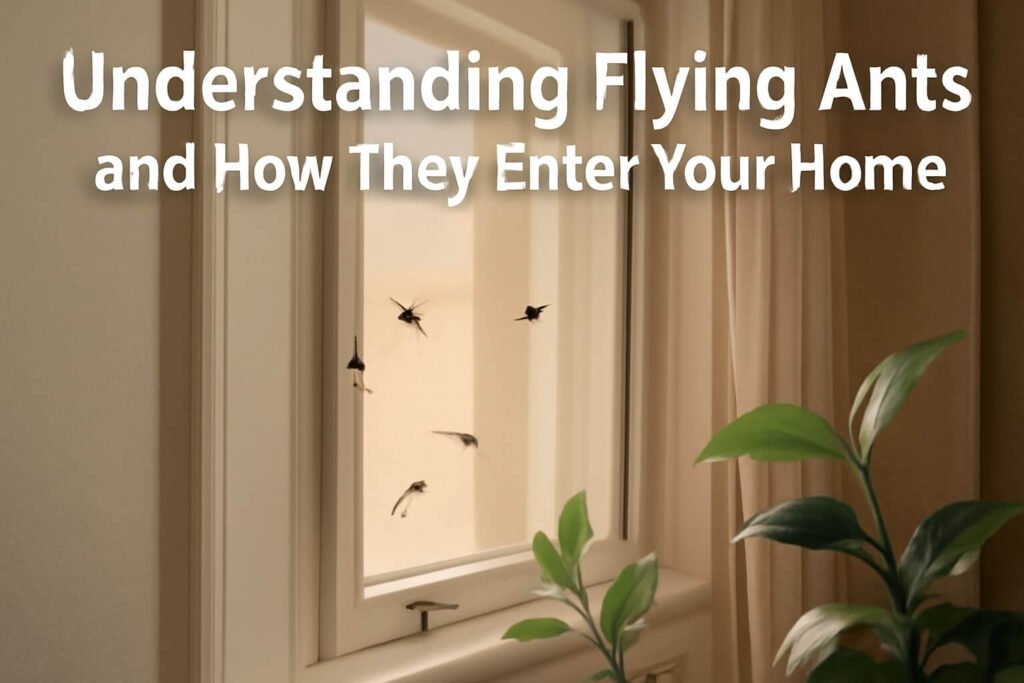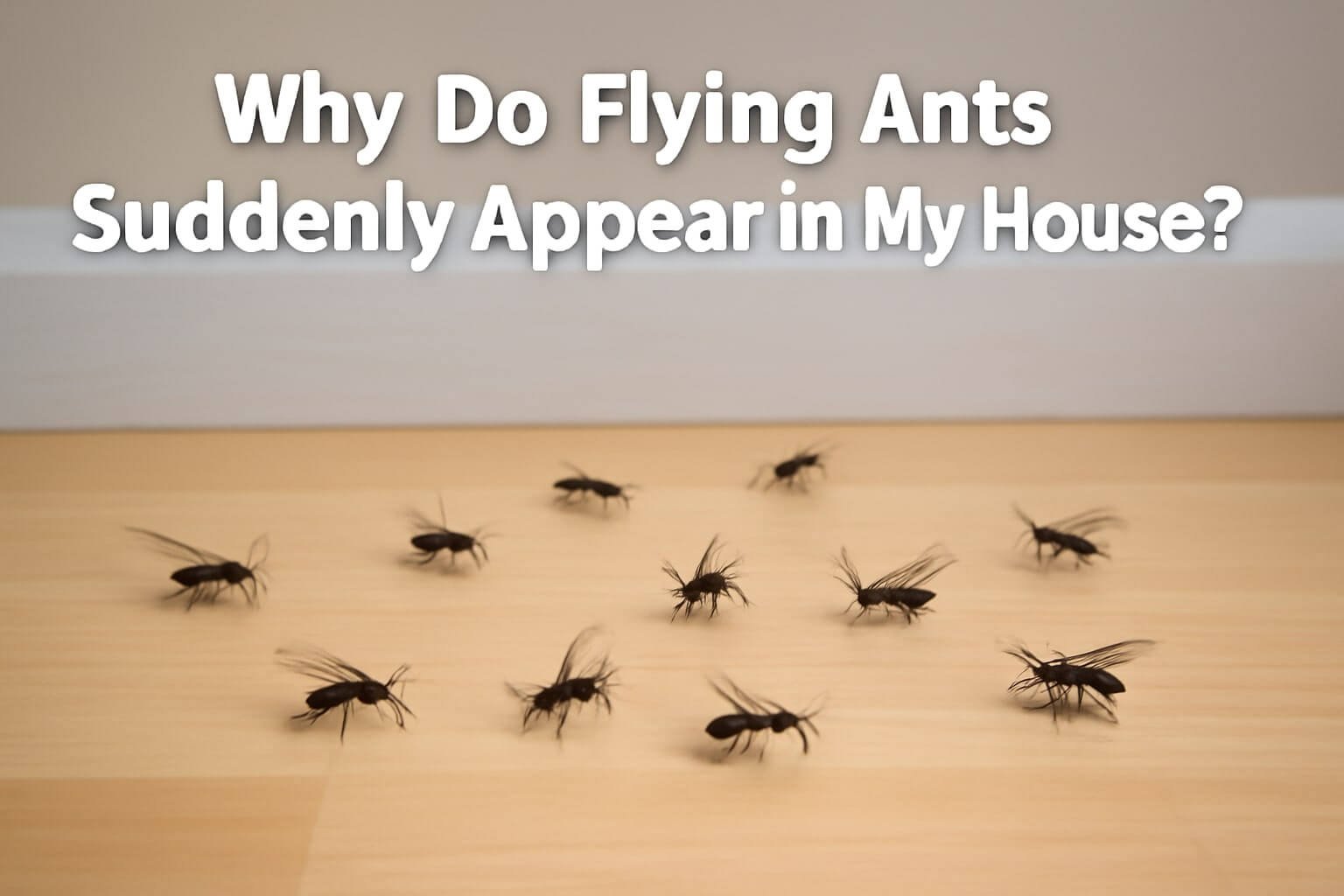Flying ants are winged forms of common ant species, usually appearing seasonally as part of their reproductive cycle. Unlike termites, which are often confused with flying ants, these insects belong to the ant family and possess distinct features such as elbowed antennae and narrow waists. Typically, flying ants emerge during warm, humid weather as they swarm to mate and start new colonies. Understanding their biology is the first step toward managing their sudden appearance inside homes.
Flying ants belong mainly to species like the black garden ant (Lasius niger) and other common ants worldwide. Their winged forms, called alates, are temporary and exist only to reproduce. Once mating is complete, they shed their wings and establish new colonies. These swarms can look overwhelming, but are natural and often short-lived.
Why Do Flying Ants Appear Suddenly?
Flying ants suddenly appear indoors primarily due to their mating swarms, which are triggered by specific environmental cues such as temperature, humidity, and weather changes. When conditions are just right—typically warm days following rainfall—large numbers of winged ants take flight to mate. Sometimes, your home becomes an accidental or convenient landing spot for these swarms.
Indoor appearances also happen because of nearby colonies inside wall cavities, under floors, or in damp wood, which produce winged ants ready to swarm. Cracks, open windows, or gaps around doors offer easy entry routes. Moreover, light sources attract flying ants at night, increasing their indoor presence during swarming periods.
Life Cycle of Flying Ants
The life cycle of flying ants is crucial to understanding why they suddenly invade homes. The cycle starts with eggs laid in established colonies. These hatch into larvae, then pupae, and finally mature into adult ants. Only at a particular stage do some ants develop wings to become reproductive alates.
Swarming occurs once the colony is mature and conditions favor reproduction. The winged males and females leave the nest in massive numbers to mate mid-air. After mating, females lose their wings and search for new nesting sites to start colonies, while males die shortly after. This natural life cycle explains why flying ants appear suddenly and in large numbers
Are Flying Ants Harmful to Humans or Property?
Flying ants are generally harmless to humans; they do not bite or sting aggressively, and their presence is more of a nuisance than a threat. However, large swarms can cause anxiety or discomfort indoors. Unlike termites, flying ants don’t typically cause structural damage, but some ant species might damage plants or food supplies.
It’s important not to confuse flying ants with termites, which can seriously damage wooden structures. Flying ants might be an indicator of a hidden ant colony, which could cause localized issues such as minor damage to insulation or electrical wiring, but this is rare.
Common Entry Points for Flying Ants in Your Home
Flying ants often enter homes through small cracks and gaps around windows, doors, vents, or foundations. Spaces around utility lines, damaged screens, or unsealed chimneys can also serve as entryways. In some cases, indoor colonies breed within walls, making it appear as though ants suddenly emerge from nowhere.
Inspecting and sealing these entry points can significantly reduce indoor swarms. Ensuring that doors and windows fit tightly and installing weather stripping are practical preventive measures.
Seasonal Patterns: When Are Flying Ants Most Active?
Flying ants typically swarm during late spring and summer, with peak activity varying based on location and climate. They are most active on warm, humid days following rainfall, conditions that soften the soil for new nests and stimulate mating behavior.
In temperate regions, swarming usually happens between May and July, while in tropical areas, it can occur year-round with seasonal peaks. Understanding these patterns helps homeowners anticipate and prepare for flying ant invasions.
Climate Influence on Flying Ant Appearances

Weather greatly influences flying ant behavior. Heavy rains followed by warm temperatures create ideal conditions for swarming. Moisture softens the soil, making it easier for queens to dig new nests. High humidity encourages winged ants to take flight and find mates.
Conversely, dry spells reduce flying ant activity as conditions are unfavorable for mating and colony expansion. Monitoring local weather can provide clues about when flying ants might appear indoors.
How to Identify Flying Ants vs. Termites
Correctly identifying flying ants is essential because they require different control methods than termites. Flying ants have:
- Narrow waists with a distinct “pinched” shape
- Elbowed antennae
- Two pairs of wings, with the front wings larger than the hind wings
Termites, by contrast, have:
- Thick, straight waists without constriction
- Straight, beaded antennae
- Wings of equal size and length
Mistaking one for the other can lead to ineffective treatment and unresolved infestations.
Preventive Measures to Stop Flying Ants Entering Your House
Preventing flying ants from invading your home involves several proactive steps:
- Seal cracks and gaps around doors, windows, and foundations.
- Install fine mesh screens on vents and chimneys.
- Keep indoor areas dry and well-ventilated to deter nesting.
- Remove food sources like crumbs or sugary spills promptly.
- Maintain outdoor landscaping by trimming plants away from the house.
- Reduce outdoor lighting that attracts winged insects at night.
These simple but effective actions minimize the chances of flying ants entering and settling indoors.
Effective DIY Treatments for Flying Ants
Home remedies can help reduce flying ants safely:
- Use soapy water sprays to kill visible ants.
- Apply natural deterrents like vinegar, lemon juice, or essential oils (peppermint, tea tree) around entry points.
- Set up ant baits to target colonies indirectly.
- Keep areas clean and dry to disrupt nesting conditions.
While DIY methods work well for small infestations, they may not be sufficient for severe problems.
Professional Pest Control Options for Flying Ants
If flying ants persist despite DIY efforts, professional pest control is the best solution. Experts can:
- Identify the species and colony locations.
- Use targeted insecticides safely and effectively.
- Provide long-term monitoring and prevention plans.
Costs vary depending on infestation size and treatment type, but often provide peace of mind and lasting results.
Environmental and Health Considerations
When dealing with flying ants, consider the environmental and health impact of pesticides. Many commercial insecticides contain chemicals harmful to pets, children, and beneficial insects. Opting for eco-friendly alternatives or integrated pest management (IPM) strategies reduces risks.
Always follow label instructions and keep treated areas well ventilated. Using natural remedies and professional advice helps balance effective control with safety.
Frequently Asked Questions (FAQs)
Why do flying ants swarm indoors and not just outside?
Flying ants swarm indoors when their nests are nearby or when attracted by indoor lights. They may accidentally enter homes during mating flights.
Do flying ants bite or sting?
Most flying ants do not bite or sting humans, but some species might pinch slightly. They are generally harmless.
Can flying ants cause structural damage?
Flying ants usually don’t cause structural damage. However, carpenter ants (which also have winged forms) can damage wood by creating nests inside.
How long do flying ants stay inside my house?
Flying ants typically stay indoors only a few days during their mating swarm, after which they die or leave to start new colonies.
Will sealing entry points completely stop flying ants?
Sealing entry points significantly reduces flying ant invasions, but doesn’t guarantee complete prevention if nests are inside the home structure.
When is the best time to treat flying ants?
The best time to treat flying ants is during or shortly after their swarming season, when colonies are active and most vulnerable.
Conclusion: Managing Flying Ants with Confidence
Understanding why flying ants suddenly appear in your house can alleviate worry and help you take effective action. These winged insects are part of a natural life cycle, often appearing due to seasonal and environmental triggers. By identifying entry points, practicing preventive measures, and knowing when to seek professional help, you can manage flying ants confidently and maintain a comfortable, pest-free home.

